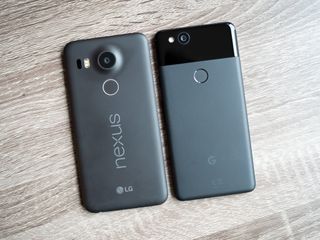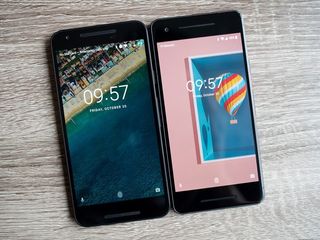Should you upgrade to the Google Pixel 2 from the Nexus 5X?

The Nexus 5x turns two years old this week. Developed in partnership between LG and Google, it was one of the last devices released under the Nexus brand as a cheaper option to the Nexus 6P.
The Nexus 5X offered a great value to Android enthusiasts looking for a reliable phone running stock Android. With the Pixel line, that budget option doesn't really exist anymore, but there's still a ton of similarities between the overall design of the Nexus 5X and the Google Pixel 2 making it a natural choice for those Google fans who loved the feel of the Nexus 5X.
Should you be considering an upgrade? Let's compare.
Hardware and specs


If you really love the form factor of the Nexus 5X, you'll find lots to love about the Google Pixel 2 — it's almost identical in size except you'll notice a significant upgrade in both build materials and internal specs.
Looking at them side by side, you can see that the Pixel 2 has slightly smaller bezels while maintaining the front-facing speakers. It's a design that some may scoff at when you compare it to other 2017 flagships like the [Galaxy S8], LG V30, and even the Pixel 2 XL, which has significantly smaller but it does let you hold the phone in landscape mode without obstructing the screen. It's ultimately a matter of personal tastes.

On the back, the camera has been shifted to the top left corner and the camera bump is also gone. There's no plastic shell to be found here, just premium aluminum and ceramic. It has quickly become an iconic look for the latest Google phones and a sign that you're rocking one of the best Android phones of the past few years.
The only hardware downgrade you could point to is the headphone jack. After throwing shade at Apple in 2016, Google has decided to do away with the headphone jack on the newest Pixel phones. In exchange, you get the latest Bluetooth 5.0 technology along with a USB-C to 3.5mm dongle included with every phone.
Be an expert in 5 minutes
Get the latest news from Android Central, your trusted companion in the world of Android
Here's a full specs comparison between the two devices:
| Category | Google Pixel 2 | Nexus 5X |
|---|---|---|
| Operating System | Android 8.0 with Google UI | Android 8.0 |
| Processor | Qualcomm Snapdragon 835 | Qualcomm Snapdragon 808 |
| RAM | 4GB | 2GB |
| Display | 5-inch 2880x1440 AMOLED Gorilla Glass 5 2.5D glass, 441ppi 95% DCI-P3 color space | 5.2-inch 1920x1080 FHD LCD Gorilla Glass 3 423 ppi |
| Rear Camera | 12.2MP f/1.8 1.4μm pixels OIS, EIS PDAF, LDAF | 12.3MP, f/2.0 1.55-micron pixels |
| Front camera | 8MP, 1.4μm pixels f/2.4, fixed focus | 5MP, 1.4μm pixels f/2.2 |
| Battery | 2700 mAh Non-removable | 2700 mAh Non-removable |
| Charging | USB-PD, 18W rapid Charging | Rapid Charging |
| Connectivity | USB Type-C, Bluetooth 5.0 | USB-C, Bluetooth 4.2 |
| Fingerprint sensor | Yes | Yes |
| Storage | 64/128GB Non-expandable | 16/32 Non-expandable |
| Dimensions | 145.7 x 69.7 x 7.8 mm | 147.0 x 72.6 x 7.9 mm |
| Weight | 143 g | 136 g |
The time is right to upgrade

Back when it was released in 2015 alongside the Nexus 6P, the Nexus 5X was the budget option starting at around $400 for the 16GB model. With the move from Nexus to Pixel, it seems that Google is now exclusively focused on creating high-end phones to compete with the other major flagships. But looking at the premium materials and spec comparison and it's pretty easy to justify the jump-up in price here. You'll once again get the best Android experience straight from the source, with all the benefits of a brand new phone.
One area in which you're sure to see better performance is battery life. A lithium-ion battery has a standard usage life of about two to three years, which means that if you haven't noticed your Nexus 5X battery performance slipping, it's likely just a matter of time. While the 5X received the Android O update, there's a number of users reporting issues after upgrading to 8.0 including some major battery drain — just another good excuse to upgrade to a new phone if you're running into issues.
You'll once again get the best Android experience straight from the source, with all the benefits of a brand new phone.
The Pixel 2 has the same sized battery as the Nexus 5X, but you should notice significantly better performance thanks in part to the Snapdragon 835 chipset along with Google's focus on improving the rapid-charging performance.
But we all know that hardware specs only count for so much — software is equally important. The Pixel 2 comes with the updated Pixel launcher and Google has confirmed that the Pixel 2 and Pixel 2 XL will receive three years of software updates and security patches (that should mean Android P, Android Q, and Android R!), meaning you'll be able to rock the latest version of on the phone you buy today well into the year 2020. If your the type who likes to commits to a phone for multiple years rather than upgrading yearly, that's great news.
By comparison, Google's support documents show that Android O will be the last major software update for the Nexus 5X, and the devices will stop receiving crucial security updates after November 2018.
Should you upgrade?
The Nexus brand catered toward hardcore Android enthusiasts, and you'll still run into folks proudly rocking the Nexus 6P or 5X because they're still good phones. The Nexus 5X was — and still is in many regards — a great phone, but if the battery or performance issues haven't already started popping up, the clock is ticking — and the timing may be right to upgrade to the Pixel 2.
If you love rocking stock Android and can afford the cost of a 2017 flagship phone, you can upgrade to the Pixel 2 with confidence knowing you're getting one of the best Android phones of 2017 and a phone that will serve you well for three years if you take care of it.
Do you think you'll upgrade?
Let us know in the comments below!
Marc Lagace was an Apps and Games Editor at Android Central between 2016 and 2020. You can reach out to him on Twitter [@spacelagace.

